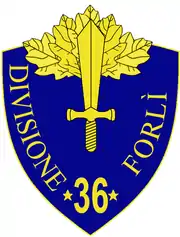36th Infantry Division Forlì
The 36th Infantry Division Forlì was a mountain infantry Division of the Italian Army during World War II. The division was formed as infantry division 31 March 1939, from the men mostly taken from the infantry brigade Monferrato. The men that formed this division were drafted in the Langhe, a geographical region in southern Piedmont. The only difference between line infantry divisions and mountain infantry divisions was that the latter's artillery was carried by pack mules instead of the standard horse-drawn carriages. Italy's real mountain warfare divisions were the six alpine divisions manned by the "Alpini" mountain troops.
| 36th Infantry Division Forlì | |
|---|---|
 36th Infantry Division Forlì Insignia | |
| Active | 1939–1943 |
| Country | Kingdom of Italy |
| Branch | Royal Italian Army |
| Type | Infantry |
| Size | Division |
| Garrison/HQ | Saluzzo |
| Nickname(s) | Forlì |
| Engagements | World War II |
| Commanders | |
| Notable commanders | Giulio Perugi |
| Insignia | |
| Identification symbol |  |
| Identification symbol | Forlì Division collar insignia |
History
In June 1940, the Forli division was the part of the First Army and took part in the Italian invasion of France.[1][2] 10 June 1940, it was deployed on the French border on defensive positions from Argentera valley and mountaintop positions from Rocca Peroni to it:Monte Maniglia. 22 June 1940, it started to attack toward Meyronnes and road junction of La Condamine-Châtelard, after bypassing French defenders north of mount Tête de Viraysse. It took the forts of Bec du Lièvre and Tête Dure 23 June 1940. As result, the Forli advanced rapidly that day, captured Malboisset and stopped just before the village of Larche, Barcelonnette at the news of Franco-Italian Armistice.
Forli was ordered in Albania, to participate in the Greco-Italian War.[3] By 12 February 1941, it already reached the frontlines in the mountains west of Lake Ohrid, on the Librazhd-Kalivaç-Dunicë line, partly by Shkumbin river banks. 20 February 1941, the Greek army started to storm the Forli position, especially at mount Maja e Kosicës and a Kalivaç in Korçë municipality. The Forli division have started to advance 10 April 1941 as part of German-led Battle of Greece. The division attacked from Vloçisht to Gurisht. By 14 April 1941, it advanced to Leminot. Afterward, the Greek army began to retreat due to the German advance in the east, and Forli division reached Ersekë on 17 April 1941, stopping at the banks of Aoös river.
After the Greek surrender the division was ordered to Larissa. The Forli was assigned occupation and coastal defence duties at Larissa, Volos and Lamia, starting from August 1942. In 1943, the Forli division has relocated further to south, covering Lamia – Amfikleia – Livadeia – Thebes area. Also, the Forli was responsible for the control of Euripus Strait, the island of Euboea and, symbolically, Syntagma Square of Athens where the Italian headquarters in Greece were located.
On 5/6 March 1943, troops of the Forli division set the town of Servia on fire in response to the defeat and capture of an Italian battalion at the Battle of Fardykambos by the Greek Resistance.[4]
The Forli Division has surrendered to the German forces in Greece after the Armistice of Cassibile and consequently dissolved 16 September 1943.[3]
C.R.O.W.C.A.S.S.
The names of four Italian men attached to the Forli Division can be found in the CROWCASS list established by the Allies of the individuals wanted by Greece for war crimes:
(Name) BOTIGLIANI (or MONTIGLIANI); (C.R. File Number) 300190; (Rank, Occupation, Unit, Place and Date of Crime) Capt. or Lt., "Forlì" Div., CC. Larissa 41–43; (Reason wanted) Murder; (Wanted by) Grc.
CAVANO – 300205 – Capt., Forlì-Div., C.C. Larissa 41–43 – Murder – Grc.
DALESSIO – 300212 – Capt. or Lt., "Forlì" Div., C.C. Larissa 41–43 – Murder – Grc.
UGOLINI Renato – 305396 – Commandant, 42 Rgt. Forli Div., Davlia (Grc.) 5.5.43 – Murder – Grc.[5]
Order of battle

Notes
- Footnotes
- An Italian Infantry Division consisted of two Infantry Regiments (three Battalions each), an Artillery Regiment, a Mortar Battalion (two companies), an Anti Tank Company, a Blackshirt Legion (Regiment of two Battalions). Each Division had only about 7,000 men, The Infantry and Artillery Regiments contained 1,650 men, the Blackshirt Legion 1,200, each company 150 men.[6]
- Citations
- Mulholland, John. "Axis Order of Battle 10 June 1940 – The Italian Invasion of France". Axis History. Retrieved 12 April 2009.
- http://www.regioesercito.it/reparti/fanteria/rediv36.htm
- Wendal, Marcus. "Italian Army". Axis History. Retrieved 12 April 2009.
- Flountzis, Antonis (1977). Στρατόπεδα Λάρισας-Τρικάλων: Η γέννηση του αντάρτικου στη Θεσσαλία [Larisa-Trikala Camps: The Birth of the Partisan Movement in Thessaly] (in Greek). Athens: Papazisis. pp. 210–211. OCLC 8624538.
- . In: The Central Registry of War Criminals and Security Suspects, Consolidated Wanted Lists, Part 2 – Non-Germans only (March 1947), Naval & University Press, Uckfield 2005, pp. 58, 60, 61, 73 (facsimile of the original document at the National Archives in Kew/London).
- Paoletti, p 170
- Paoletti, Ciro (2008). A Military History of Italy. Greenwood Publishing Group. ISBN 0-275-98505-9.